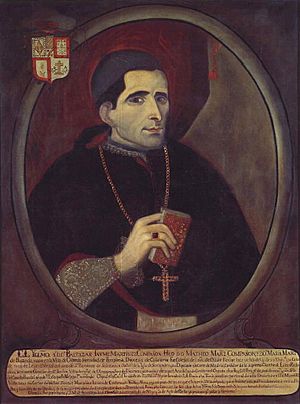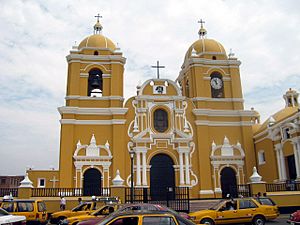Codex Martínez Compañón facts for kids
The Codex Martínez Compañón is a very special collection of nine large books. It was put together between 1782 and 1785 by a bishop named Baltasar Jaime Martínez Compañón. He was a bishop in a place called Trujillo, Peru.
This amazing work contains 1,411 beautiful watercolour paintings. It also has 20 musical pieces. The Codex shows us what life was like in the bishop's area, called his diocese, during that time.
Bishop Martínez Compañón sent this important work to Charles IV of Spain, who was the king. In 1803, the king added it to the Royal Library. The musical parts in the Codex were likely written down by Pedro José Solis. He was the music director at Trujillo Cathedral from 1781 to 1823.
Contents
What's Inside the Codex?
The Codex Martínez Compañón is like a time capsule from the 1700s. It gives us a detailed look at the people, places, and nature of Peru.
The 1,411 Paintings
The many watercolour paintings in the Codex are full of life. They show us:
- How the local people, especially the Indigenous communities, lived every day.
- The different kinds of clothes people wore.
- Their customs and traditions.
- A wide variety of plants, animals, and natural scenes from the region.
The 20 Musical Pieces
The Codex also includes 20 musical examples. Most of these songs are quite short, usually lasting only two or three minutes. They offer a glimpse into the music played in Peru during the late 1700s.
Here are some of the songs found in the Codex:
- Cachua: Al Nacimiento de Christo Nuestro Señor (A dance song for the birth of Christ)
- Tonada: La Brugita, de Guamachuco (A popular song from Huamachuco)
- Tonada: El Congo (A song that shows the influence of African slaves in the area)
- Tonada: El Tuppamaro de Caxamarca (A song from Cajamarca)
- Tonada del Chimo (A song from the Chimú culture, believed to be the only surviving song in the old Mochica language)
- Dance: Baile del Chimo, Folio 179 (An instrumental dance)
- Tonada: El diamante, de Chachapoias (A song from Chachapoyas)
- Tonada: La Lata ("The Can" - a popular song)
- Tonada: La Selosa, del pueblo de Lambayeque ("The Jealous Woman" - a song from Lambayeque)
- Tonada: El Conejo ("The Rabbit" - a popular song)
- Tonada: El Huicho, de Chachapoyas (Another song from Chachapoyas)
- Dance: Bayle de danzantes con pifano y tamboril (An instrumental dance with flute and drum)
- Tonada: La Donosa (A graceful song)
- Cachuyta de la montaña: "El Vuen Querer" (A mountain dance song, "Good Love")
- Cachua a duo y a quatro: Al Nacimiento de Christo Nuestro Señor (A dance song for the birth of Christ, for two or four voices)
- Lanchas para baylar, Folio 186 (An instrumental dance, unique to the Codex)
- Tonada: El Tupamaro de Caxamarca (Another song from Cajamarca)
- Tonadilla: El Palomo, del pueblo de Lambayeque ("The Dove" - a short song from Lambayeque)
- Cachua Serranita: El Huicho Nuebo, a Nuestra Señora del Carmen, de la ciudad de Trujillo (Otusco) (A mountain dance song from Trujillo)
- Cachua: La Despedida, de Guamachuco (A farewell dance song from Huamachuco)
Modern Recordings of the Music
Today, you can listen to these old songs! Many groups have recorded music from the Codex. Here are a few examples:
- Al uso de nuestra tierra (In the style of our land) by Música Temprana.
- The complete Codex Martinez Companon by Capilla de Indias.
- "Bailes, Tonadas & Cachuas" (Dances, Songs & Cachuas) by Música Temprana, released in 2013.
See also
 In Spanish: Códice Martínez Compañón para niños
In Spanish: Códice Martínez Compañón para niños



